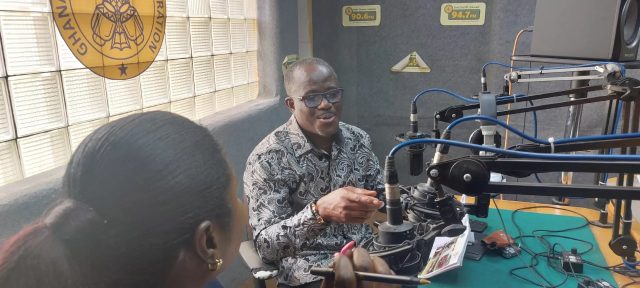By: Rebecca Ekpe
‘’So when we combine the whole of Africa you can have the numbers high, but when you want countries where specific numbers have been removed it’s Ghana.1 out of 5 children is in child labour but now it’s coming down’’, according to the Deputy General Secretary of the Agricultural Workers Union, (GAWU), Andrews Addoquaye Tagoe.
Mr. Tagoe, who is also the Regional Coordinator, Africa Global March Against Child Labour disclosed this in an exclusive interview with Rebecca Ekpe.
International Labour Organization, (ILO) says for the first time in 20 years, child labour is on the rise.
‘’160 million children, almost one-in-10 worldwide, are in child labour. What’s worse, half – 80 million – are in the most hazardous forms of child labour; that’s work with a real threat to their physical and mental health’’.
Why Child Labour Persists:
Experts remain positive that economic factors underline the Child Labour menace. Children largely in low income areas are the ones that fall victim.
Simply put, poverty is the reason children are forced into the drudgery of having to make ends meet at an early age, thereby having their education and future truncated.
A Minerals Commission Survey shows that Child labour has taken a new twist, according to Mrs. Bernice Botchway, who is responsible for Gender and International Affairs at the Minerals Commission.
‘’Child Labour has taken a new twist where children work in extreme danger to fend not only for themselves but, sick parents and the whole family’’.
Mrs. Botchway who is also the Chairperson of the Mobilization, Communication and Advocacy Committee on Child Labour, identified ‘’lack of knowledge, policy implementation and poverty as the major factors hindering progress to eliminate Child Labour’’.
Policy intervention:
Fundamentally, the General Agricultural Workers Union, GAWU says although not a direct responsibility, children found at work instead of school, should be helped to return to the classroom.
”When we identify children in the community we will support them to go to school, they are not necessarily our responsibility but to support parents to take care of their children’s needs”, Mr. Tagoe posits.
He agrees that with regard to policy,a multi-faceted approach is the andedote to handling the issues of child labour.
”One thing that buffles me is a report that came out on the fact that of all the years that have past child labour is still on the rise”.
He was however optimistic about the future if policies align.
”I’m seeing a report released by the ILO that of all the years that have past child labour is still on the rise. Theport is still more devastating because I know the ILO report was released in 2020 and when you look at that report, 160 million children around the whole world have become victims to child labour, Africa alone is higher than the rest of the world combined”.
”So when we combine the whole of Africa you can have the numbers high, but, when you want countries where specific numbers have been removed it’s Ghana.1 out of 5 children is in child labour but now it’s coming down”, Mr. Tagoe explains, and says knowlege has increased about the subject matter to some extent.
For example, on the issue of who is a child worker? The Ministry of Gender, Children and Social Protection and its stakeholders are working on a document in this regard to reflect the Ghana situation, which will translate into the National Plan of Action”.
The Regional Coordinator, Africa Global March Against Child Labour says the document is almost complete.
”I will say it’s 90 percent ready, we had a draft with which we experimented with it’s called the hazardous activity framework which spells out age-appropriate work for every child, so that we can know both the work that will affect a child’s health, education and morals”.
In the Ghanaian scenario, ”work that can affect a child’s development in the Ghanaian context has all our cultural values in terms of people raising their children to take up their professions”.
Child Labour in Oti Region
Some successes have been chalked up in eliminating child labour. Kpando Torkor in the Volta Region is a success story.
The Regional Coordinator, Africa Global March Against Child Labour, Andrew Tagoe said, some work will be extended to the people of Abotoase in the Oti Region, where the Children refuse to attend school on market days.
”When we went to visit the Paramount Chief of Tepa, he told us it’s a problem that he himself relates to and all he has been waiting for is support from the Union and other partners to extend the child labor free zone to Oti”.

”According to the Chief in the Abotoase town, they have several market days and every market day the children declare it a holiday”, Mr. Tagoe narrates.”
”So, if you’re a teacher and you come to school on a market day it’s your own problem. And what are they doing? They are doing business on the lake. Both boys and girls.
This is one problem he (Chief) wants to solve”, according to Mr. Tagoe.
”The problem they’re facing in Abotaese is that children don’t go to school on market days”.
Besides child delinquency, there are other socio-economic concerns that GAWU hopes to tackle in the quest to ensure a child labor free zone in the Oti Region.
”The other problem is when you go to the lake, you’ll find a lot of plastic waste and plastic waste is detrimental to fishing because when the fish consumes it, they die.”
”Cleaning the beach and planting some trees along the area should be carried out”.
”So, it’s not just child labor, but we also look at the economic conditions of the fishermen, how they get their fishing nets, support what the Assemblies are providing for them, how the Fishery Department is working with them and sometimes we meet the Ghanaian Navy to help monitor activities on the Lake Volta”, Andrews Tagoe narrates.
CLICK HERE FOR MORE GENERAL STORIES


















